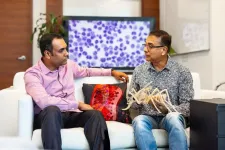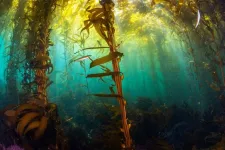(Press-News.org) The National Science Foundation has awarded $3.7 million to the University of Chicago for the first year of a grant that may provide up to $21.4 million for the final designs for a next-generation set of telescopes to map the light from the earliest moments of the universe—the Cosmic Microwave Background.
Led by the University of Chicago and Lawrence Berkeley National Laboratory, the collaboration seeks to build telescopes and infrastructure in both Antarctica and Chile to search for what are known as “primordial” gravitational waves—the vibrations from the Big Bang itself. It would also map the microwave light from the cosmos in incredible detail and reveal how the universe evolved over time, as well as investigate the mystery known as dark matter.
This award will fund the continuing designs for the telescopes and cameras, working towards construction readiness. The entire project, known as CMB-S4, is proposed to be jointly funded by the National Science Foundation and the U.S. Department of Energy; it is expected to cost on the order of $800M and to come fully online in the early 2030s. The collaboration currently involves 450 scientists from more than 100 institutions, spanning 20 countries.
“With these telescopes we will be testing our theory of how our entire universe came to be, but also looking at physics at the most extreme scales in a way we simply cannot do with particle physics experiments on Earth,” said John Carlstrom, the Subrahmanyan Chandrasekhar Distinguished Service Professor of Astronomy and Astrophysics and Physics, who serves as the project scientist for CMB-S4.
The biggest questions
The cosmic microwave background is the light still traveling across the universe from the earliest moments after the Big Bang. Because it carries information about the birth of the universe, scientists have built incredibly complex instruments to map that light, from spacecraft and from the ground in the Chilean Atacama Plateau and at the NSF’s South Pole Station—including the current South Pole Telescope, which has been operating since 2007.
But we need to build a new generation of telescopes in order to answer the biggest questions—like whether our universe began with a burst of expansion at the dawn of time, known as inflation, which would have stretched miniscule quantum-mechanical fluctuations into the initial seeds of all of the structure in the universe today.
CMB-S4 would involve telescopes in two locations: a large telescope and nine smaller ones in Antarctica, and two large telescopes in the mountains of Chile. Each site plays an essential role in achieving the project’s scientific goals.
The telescopes in Chile would conduct a wide survey of the sky, trying to capture a fuller and more precise picture of the cosmic microwave background—and through it, helping us to understand the evolution and distribution of matter in the universe. The project can also look for evidence of “relic” light particles that many theories suggest may have existed in the early universe. CMB-S4 should provide clues on the nature of the mysterious stuff known as dark matter, as well as the dark energy that is causing the expansion of the universe to accelerate.
Meanwhile, the telescopes at NSF’s South Pole Station would take a very deep, sustained look at a smaller part of the sky. “The South Pole is the only location that allows a telescope to look at one place in the sky continuously, because it’s at the pole where the rest of the Earth spins around,” explained Jeff Zivick, deputy project manager for CMB-S4.
This would allow the telescopes to look for evidence of what are called primordial gravitational waves—the ripples in space-time that would have been created if the universe really did explode into being from a space much smaller than a single subatomic particle. These ripples would interact with the cosmic microwave background, creating a distinct but extremely faint signature.
This is an ambitious goal. “In many ways, the theory of inflation looks good, but most of the experimental evidence is somewhat circumstantial,” said Jim Strait, a physicist at Lawrence Berkeley National Laboratory and the project director for CMB-S4. “Finding primordial gravitational waves would be what some people have called ‘the smoking gun’ for inflation.”
Primordial gravitational waves would also be evidence to connect the force of gravity with the laws of quantum mechanics. The mismatch between the two theories, one which applies at the very largest scales in the universe and the other at the very smallest, has been plaguing scientists for decades.
Finalizing designs
The new award from the National Science Foundation will help to fund the design work for the new telescopes and infrastructure at the sites. Going from conceptual design to final design involves analysis, simulations and modeling, and testing components of the telescopes. Although the underlying technology is well understood and has been field-tested, the design work for CMB-S4 is especially important because several of the telescopes will be the most complex of their kind ever built.
CMB-S4 is expected to have nearly 500,000 superconducting detectors, a significant increase over all precursor cosmic microwave background experiments combined. Carlstrom explained that the detectors are already so sensitive that the noise in the measurement is dominated by the background noise of everything else in the sky and atmosphere. The plan, therefore, is to greatly increase the number of measurements and average them to provide a precise measurement of the signal level and greatly reduce the noise.
The increased number of detectors will also require many other components of the project to scale up in size. “For example, we will need to build multiple cryostats, larger than we have ever built before, to effectively cool all these detectors to a temperature near absolute zero,” said Assoc. Prof. Brad Benson, a scientist at UChicago and Fermilab who is leading the effort to design the large camera cryostats for CMB-S4.
The CMB-S4 project is expected to be funded by the National Science Foundation and the U.S. Department of Energy. The National Science Foundation portion of the project is led by the University of Chicago, while the Department of Energy’s portion is led by Lawrence Berkeley National Laboratory.
END
NSF awards up to $21.4M for design of next-gen telescopes to capture earliest moments of universe
Instruments would help us understand the beginning, history, and makeup of the universe
2023-10-26
ELSE PRESS RELEASES FROM THIS DATE:
Malaria protein discovery offers path for novel antimalarial intervention strategies
2023-10-26
The discovery of a malaria protein that helps the parasite grow inside red blood cells and plays a key regulatory role in the parasite’s immune evasion tactics could pave the way for new vaccines or therapeutics to combat the deadly infection.
The protein, known as PfAP2-P, was previously identified in a KAUST-led study that explored malarial genes and proteins displaying rhythmic 24-hour expression patterns — an adaptation that allows the parasite to synchronize its activities with those of the host during the human blood stage of its developmental cycle[1].
The expression levels of PfAP2-P seem to peak first around ...
Psoriasis not caused by spontaneous mutations in skin cells
2023-10-26
Psoriasis — a chronic skin condition — is not caused or spread by spontaneous genetic mutations in the skin, new research suggests.
The team, from the Wellcome Sanger Institute and collaborators, sequenced skin samples from 111 people with psoriasis. They didn’t find any mutated genes in the psoriatic patches that weren’t also mutated in the individual’s unaffected skin tissue.
The study, published today (26 October) in Nature Genetics, suggests that unlike other inflammatory diseases, such as inflammatory bowel disease or chronic liver disease, somatic mutations were not responsible for the start or spread of psoriasis.
Confirming that psoriasis ...
Marine protected areas and climate change
2023-10-26
An international team has developed the first comprehensive framework for designing networks of marine protected areas that can help vulnerable species survive as climate change drives habitat loss.
In a paper published Oct. 26 in One Earth, the researchers outlined guidelines for governments to provide long-distance larval drifters, like urchins and lobsters, as well as migratory species, like turtles and sharks, with protected stopovers along coastal corridors. Led by Stanford marine conservation scientist Nur Arafeh-Dalmau, the team included 50 scientists and practitioners ...
Genetics links endometriosis and IBS
2023-10-26
University of Queensland researchers have shown that endometriosis and irritable bowel syndrome (IBS) share genetic risk factors, explaining why patients with one condition may also have the other.
Professor Grant Montgomery and Dr Sally Mortlock at UQ’s Institute for Molecular Bioscience found a significant relationship between the risks for endometriosis and common gastrointestinal disorders such as IBS, peptic ulcer disease (PUD) and gastro-oesophageal reflux disease (GORD).
“This genetic finding supports the clinical observation of an increased incidence of gastrointestinal disorders in women with endometriosis,” ...
Regenstrief, VA researchers co-edit journal special supplement addressing far-reaching impact of EHR transitions
2023-10-26
INDIANAPOLIS -- Two Regenstrief Institute and U.S. Department of Veterans Affairs researchers are key leaders of a national journal’s special supplement designed to help address the plethora of issues that can accompany a healthcare system’s transition to a new electronic health record (EHR) system.
Regenstrief Institute’s David Haggstrom, M.D., MAS, and Michael Weiner, M.D., MPH, are among four guest editors who have spent the last two years leading content development for a Journal of General Internal Medicine (JGIM) special supplement ...
City of Hope, TGen awarded five-year, $4.5 million grant to advance liquid biopsy for pancreatic cancer
2023-10-26
LOS ANGELES and PHOENIX — City of Hope®, one of the largest cancer research and treatment organizations in the United States, and TGen are leading an international group that has been awarded $4.5 million to validate a liquid biopsy for the early detection of pancreatic cancer. The blood-based diagnostic developed by the National Cancer Institute’s Pancreatic Cancer Detection Consortium (PCDC) leverages exosomal microRNAs that serve as a biomarker or unique RNA fingerprint for the early detection of disease or recurrence.
Enrollment of patients with early-stage pancreatic ductal adenocarcinoma (PDAC), a ...
Mount Sinai receives $4.6 million from The Pershing Square Foundation to support women’s health research and careers for women in science
2023-10-26
(New York, NY – October 26, 2023) – The Icahn School of Medicine at Mount Sinai has received a $4.6 million gift from The Pershing Square Foundation to support women’s health research and advance careers for female scientists. Part of an original nearly $21 million gift that expanded a COVID-19 testing program for New York City schools and other organizations, this boost in women-focused initiatives connects The Pershing Square Foundation’s interest in supporting women in science to Mount Sinai’s leading researchers and key initiatives in gender-based science and health.
“We ...
Announcing the ADA Forsyth Institute: a world-class organization for oral health research and innovation
2023-10-26
SOMERVILLE, Mass., Oct. 26, 2023 – The American Dental Association (ADA) and the Forsyth Institute today announced the formation of the ADA Forsyth Institute, which brings together unparalleled talent, visionary research opportunities and dynamic innovation prospects, dedicated to advancing oral health through scientific innovation and research.
“The new ADA Forsyth Institute will continue to advance oral and overall health through ground-breaking research and innovation,” said Massachusetts Governor Maura Healey. “The Forsyth ...
Early whaling eradicated species from local waters
2023-10-26
The industrial whaling of the 19th and 20th centuries almost wiped out several species. However, even though whaling took place on a much smaller scale before this period, it was enough for at least two species to disappear completely from European waters.
These two species used to be among the most common, but now one of these species is on the verge of extinction.
“Whaling was widespread from a very early time. This had major consequences for species in Europe,” says Youri van den Hurk, a ...
Fungi used in food production could lead to new probiotics
2023-10-26
Washington, D.C. — Many fungus strains have been used and selected by the food industry for their capacities to ferment, produce flavors or produce heterologous molecules. According to a new study, 2 fungi used to produce food products have potential probiotic effects on gut inflammation. The study, published in mSystems, a journal of the American Society for Microbiology, demonstrates a possible new way to develop new probiotics.
“There is much to learn by studying the role of the ...
LAST 30 PRESS RELEASES:
Why swearing makes you stronger
What prevents more cancer patients from enrolling in potentially life-saving clinical trials?
UK’s worst-case climate risks laid bare for lawmakers
A decline in churchgoing linked to more deaths of despair
TAMEST announces Maralice Conacci-Sorrell, Ph.D., UT Southwestern Medical Center, as 2026 Mary Beth Maddox Award & Lectureship Recipient
Global study to evaluate whether dengue outbreaks can be anticipated earlier
Chonnam National University researchers propose innovative voltage-loop control for power factor correction
Accelerating next-generation drug discovery with click-based construction of PROTACs
Detecting the hidden magnetism of altermagnets
$7M gift supports health research, engineering and athletics at UT San Antonio
NU-9 halts Alzheimer’s disease in animal model before symptoms begin
Hospitals acquired by real estate investment trusts associated with greater risk of bankruptcy, closure
City of Hope scientists study rare disorder to uncover mechanism and hormone regulation underlying fatty liver disease and sweet aversion
Your genes may influence gut microbiome of others, rat study shows
‘Personality test’ shows how AI chatbots mimic human traits – and how they can be manipulated
Global food systems driving twin crises of obesity and global heating
Osaka Medical and Pharmaceutical University researchers capture real-time molecular movies of enzyme catalysis
Could your genes influence the gut microbiome of others?
Clues to Alzheimer’s disease may be hiding in our ‘junk’ DNA
Study reveals that the body uses different sensors to detect cold in the skin and in internal organs
iPS cells from dish to freezer and back
Deep neural networks enable accurate pricing of American options under stochastic volatility
Collective risk resonance in Chinese stock sectors uncovered through higher-order network analysis
Does CPU impact systemic risk contributions of Chinese sectors? Evidence from mixed frequency methods with asymmetric tail long memory
General intelligence framework to predict virus adaptation based on a genome language model
Antibiotic resistance is ancient, ecological, and deeply connected to human activity, new review shows
Vapes, pouches, heated tobacco, shisha, cigarettes: nicotine in all forms is toxic to the heart and blood vessels
From powder to planet: University of Modena engineers forge a low-carbon future for advanced metal manufacturing
Super strain-resistant superconductors
Pre-school health programme does not improve children’s diet or physical activity, prompting call for policy changes, study finds
[Press-News.org] NSF awards up to $21.4M for design of next-gen telescopes to capture earliest moments of universeInstruments would help us understand the beginning, history, and makeup of the universe





